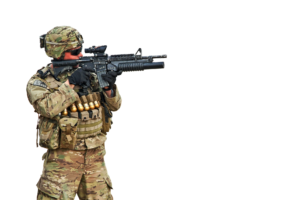Special Ops Training: Firearm Training
We’ve gone over just how tough spec ops are. From Special Operative training to their combat applications, Special Operations are believed to have the hardest jobs. For exceptionally tough individuals, you’ve got to have extraordinarily tough training. Here’s the spec ops training that focuses on firearms.

Spec Ops Training for Firearms
Proper weapon handling
The best training for spec ops and firearm use is not an easy one. It seems as though firearm training would be pretty standard, right? Well, no one shoots like a spec op. It boils down to every detail, starting with how you handle your rifle.
- Finger outside the trigger guard (never lay your finger along the trigger)
- Keep your elbows in, close to your body
- Slightly bend the knees
- Always use the sights!
That last one is a basic shooting fundamental that every spec op knows. It’s something that is often overlooked in movies and TV shows and, therefore, we learn to use assault rifles the wrong way.
Learning short range combat
After you go over the basics in spec ops training (you should already be familiar with those basics before being selected for spec ops), it’s time to apply weapons handling in an environment where you learn basic short range combat. What is short range combat? Short range combat encompasses combat styles like hand-to-hand and close quarters combat.
SRC is a unique firearm training for spec ops because, not only does it test a soldier’s firearm skills, but their physical strength and survival instinct. In any worst case scenario, the spec op training involves a plan B. Very useful in any situation. SRC training involves:
- Firing stance: Feet are shoulder-width apart, toes pointed straight ahead.
- High ready position: the end of the weapon is held under the armpit, barrel held slightly up just in peripheral vision of the spec op.
- Low ready position: The barrel is held down at a 45-degree angle.
- Movement: Spec ops are trained to run around, holding their weapons in the appropriate manner while staying focused in on their target. No soldier should have to look where they are going and must not trip over anything in the process.
- Kneeling: spec ops are trained to combat enemies from a kneeling position.
- Aiming: When practicing their aiming, four different aiming techniques are practiced; slow aimed fire, rapid aimed fire, aimed quick kill and instinctive fire.
Tactical reloading
In the line of duty, thinking and acting quickly is the name of the game. One of the more time-consuming aspects of firearm use is reloading your weapon. In a firefight, spec op training goes over ways to reduce this time greatly with tactical reloading. Whilst reloading, spec ops learn to:
- Keep barrel on target at all times
- Forcefully pulling empty magazine out and dropping it
- Just as quickly as it was dropped, insert new magazine without moving rifle
- Quickly chamber the round
The trick is to do all that with one hand while steadying the rifle with the other.
Practice makes perfect
Spec ops training takes time, and these tasks that you learn aren’t something you can learn in a weekend. That’s why spec ops training takes months at a time to complete one task. It’s no walk in the park, and no one expects anyone to pull it off, but if you have what it takes to be a spec op, this is what the basic firearm training entails.
Get a Taste of Spec Ops Training
While obviously not the real thing (we wouldn’t do that to you), Machine Gun Experience offers a package that allows you to fire all of the weapons a spec op in training would be using. Book your experience today.

